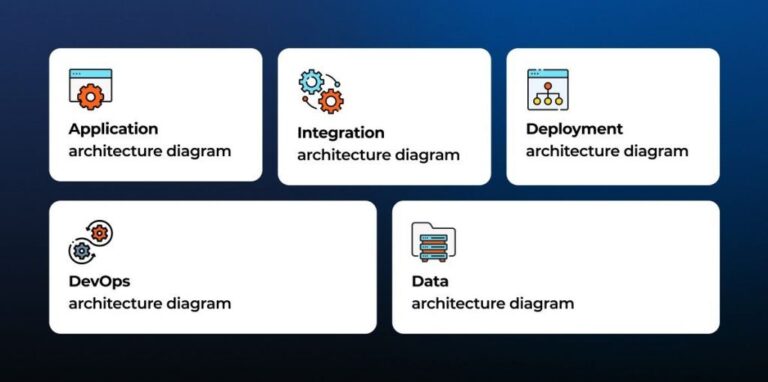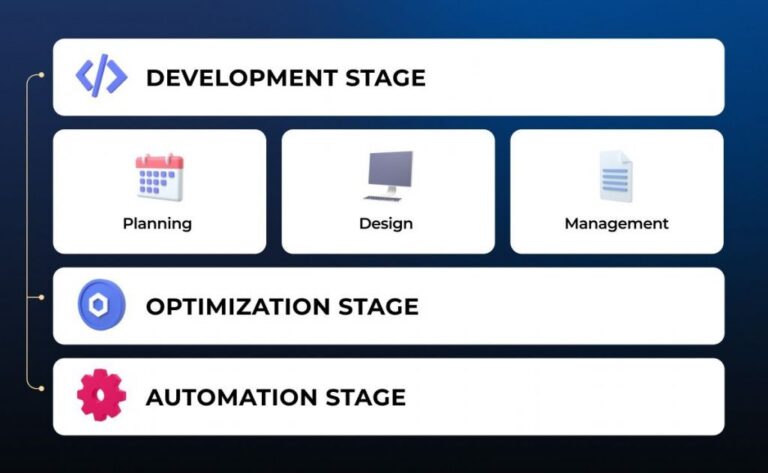Table of Contents
Information technology or technical architecture is the consistent process of specifying, acquiring, developing, and adjusting IT solutions required for the business process of a certain company.
IT architecture includes the hierarchy and application of all existing computer systems and hardware solutions integrated within inner processes for the purpose of its correct work and interaction with one another.
For instance, with every new software implementation, the newly developed solution has to be placed in the entire business IT architecture diagram.
5 types of technical architecture diagrams
To visually outline the technical architecture of a particular software solution, engineers use various types of architecture diagrams to depict the parts of the solution’s functionality and its interaction with other inner systems, processes, and employees.
The more details such diagrams contain, the more accurate choice of the software development approach and technology selection will be for the development team.
Further, we would like to highlight the primary type of technical architecture diagrams and their applications in software projects.

Application technical architecture diagram
The set of existing business software apps creates a single internal software system, integrated with various applications and features according to current business demands.
The application architecture diagram stands for the components of a new software application that is expected to be implemented into the unified inner system.
These documents precisely describe the functioning of the new solution, its interaction with other applications and databases, and its application within the company departments including responsible employees for its use.
Moreover, thanks to separately integrated apps, each of them can be upgraded independently of the inner ecosystem with no interruption in its work.
Integration architecture diagram
The integration architecture diagram is responsible for the direct process of integration of newly made applications into the existing software system within your company.
To avoid system errors and outages, the process of integration needs to consider the possible scenarios that may occur and the solution to the issues that may arise.
Such a diagram outlines how exactly the new solution will interact with other existing applications and how they will work smoothly together after the implementation stage.
Deployment architecture diagram
The deployment architecture diagram outlines the growing and upgrading of the entire system, including each integrated application.
Such a diagram commonly contains information about the maximum number of users and components (apps) that can be added to the system to ensure all software resources are scalable and can grow with your business simultaneously.
DevOps architecture diagram
The DevOps architecture diagram is used by technical architects to reveal the system’s weak points and potential errors, monitor the process of integration, work on a newly deployed tool for the ecosystem and manage app configurations.
Once to define the smooth flow of integration of new applications, this approach can be applied for the next required implementations.
Data architecture diagram
Business data storage is one of the most important components of any software system that allows providing insight based on analysis of data from different sources and company departments.
Data architecture diagrams precisely depict the process of collection of data from internal and external sources, it’s storage, processing, and access.
This diagram helps optimize the way data is collected to allow software systems to process huge amounts of data with no impact on system functionality.
Types of technical architects
Technical architects focus on building software system architecture for a certain business company.
Each to entail execution of responsibilities on different levels starting from a single software project to planning the general strategy of information technology acquiring for a company.
Further, we would like to get you aquatinted with the common type of IT architects on various projects and what duties are included in their daily plans.
Enterprise architecture specialist
Enterprise architects are specialists that develop an overall enterprise architecture strategy for your business.
This type of technical architect doesn’t type the certain software system you need to integrate, but helps to determine the ongoing business requirements and specify the features these solutions need to include.
Overall, they define software applications that are required to follow your current business strategy and reach planned annual business objectives.
Infrastructure Architect
An infrastructure architect is quite similar to an enterprise architect but has more technical tasks and responsibilities.
Generally, infrastructure IT architecture design is tasked with ensuring the smooth work of the integrated business software systems in case of scaling the solutions as well as business scale up.
They need to back up the software apps so that these solutions could work correctly, keeping the private data under higher loads and expanding business processes to manage with software.
Software Architect
A software architect is a technical-related engineer whose task is to create the correct IT architecture for each integrated software solution within your company.
Depending on the type of software app your software development team builds, the software architect outlines the features of the future solutions, their interaction with one another and other business software systems and databases, and overall, how the system works from the inside.
Duties and responsibilities of IT architect on the software project
Talking about the general duties and responsibilities of IT or technical architect on a software project, we would like to highlight the main tasks and challenges this type of engineer need to handle:
- Analysis of the current business software apps to assess their suitability to ongoing requirements and overall effectiveness for the execution of the tasks they are applied for;
- Define the newly required software and hardware implementation in order to correlate with a business plan and reach the initially set business goals, ensuring their achievement with the available range of software apps or recommendations what kinds are still required to develop;
- Keep stakeholders up to date about the current IT structure of the company and the progress in business strategy execution;
- Creating and testing new network systems that can grow simultaneously with the company;
- Resolving software system and network errors, ensuring smooth work of all departments and software systems within the company.
The roles of the technical architect
At this point, we would like to take a close look at the roles and some more responsibilities technical architects commonly have as a part of an in-house or outsourcing development team.
Indeed, the range of tasks and duties are peculiar to each company’s business needs and requirements at the moment, number of existing software systems, number of employees, and scaling plans.
Planning role
Each software project and the process of its building has to be precisely planned, where app architecture is the second vital stage of development.
Technical architecture is taken with outlining the future software structure (roadmap) where the client can clearly see the role of this solution in the entire company software infrastructure, its functionality, and interactions.
IT architects technically divide the software project into iterations, each of which stands for a certain part of solution functionality, including the required resources and engineers to execute each sprint.
Team lead
The technical architect is included at the core of any development team, cooperating with specialists and engineers within the theme team during the entire development process.
So, basically, tech architects could be named team leads in some ways as they build the plan of IR procurement and the architecture of the future solutions while the team turns these plans into functional systems.
Technical architecture development life cycle
The development process of the architecture of software systems that consists of various apps and tools is divided into three main stages, particularly development, optimization, and automation.
These three stages are the core components of the technical architecture life cycle for your business company.
And further, we would like to take a closer look at each of these stages and their role in the technical architecture overall.

The development stage
Basically, the development part of the technical architecture life cycle consists of three steps – planning, design, and management, each of which required taking actions and vital decisions.
Planning
At this point, the development team builds a business strategy for acquiring new software solutions on an enterprise level by evaluating the ongoing technical architecture and planning its scale.
It is pivotal to define the business vision and business value, define the current requirements and outline the future expectations of growth, and so on.
Design
As the system architecture is going to change, the team is tasked with comparing the current and expected architectures to reveal discrepancies, risks, and dependencies and fix them before the deployment of a new tool to the system.
Thus, the technical architect creates the roadmap that outlines the precise action plan or architecture pattern to execute the integration of the newly made solution into the entire company software architecture.
This pattern can also be applied to other implementation as repeatable action.
Management
This level entails the approval of the architectures and roadmap with stakeholders to address any concerns they have.
You have to ensure the architecture can be scaled in the future, and also constant management of the delivery team to make sure they follow the initially selected frameworks and approaches in building and integrating of new solutions.
Optimization stage
Despite the type of software apps your inner processes are implemented with, each of these solutions needs regular reviews and upgrades in functionality, and technical architecture in order to provide your company with the highest possible value and benefits.
Regular reviews of architecture improve the quality of the software system, making it more efficient for your business processes.
Automation stage
Surely, the correct creation of technical architecture depends on the technical skills of the IT architecture engineer you hire for your software development project.
Nevertheless, technical architects play a key role in adopting various automation tools to create diagrams and roadmaps like Diagrams.net, Visio, and others. Such tools and resources enable data management in one place, allowing its easy access and management.How to hire a technical architect?
There are three basic ways you can cooperate with technical architects – as a part of your in-house development team, as an outstaff engineer from remote software providers, or as a part of the outsourcing development team.
Taking into account the aforementioned duties and responsibilities of a technical architect, it is clear that this engineer is indispensable in any software project from solution ideas to software product launch and maintenance.
For instance, if you hire an outstaff IT architect, you need to ensure the consistency of your cooperation as it is recommended to work with the same specialist who developed the initial software infrastructure for your company.
At Altamira, the technical architect is included in the core outsourcing development teams we provide our clients with as we know that the IT architecture of the software solution defines the success of its development, deployment, and feasibility for your business.
IT architects play a significant role in planning and implementing information technology solutions into existing systems within your company processes.
This engineer cannot be a separate part of the development team that develops software solutions for your business requirements.
Once you create an in-house development team, an IT architect becomes your consultant in building and upgrading software apps.
If your inner team resources are lacking the solution architect to design a new solution or your business required consultation from an enterprise architect to provide your development team with fresh insights and strategies, just contact our team, so we could plan further consultations with your tech team.
FAQ
A technology architecture diagram is a visual representation of the various components of a system, including hardware, software, and network elements.
It illustrates how these components interact and work together to achieve the system’s goals.
Such diagram helps stakeholders understand the system’s design and facilitates communication among team members.
The structure of technical architecture typically includes several key layers:
- Presentation Layer: This is where user interactions take place, often involving web or mobile interfaces.
- Application Layer: This layer contains the business logic and application services.
- Data Layer: Here, data storage solutions, such as databases and data warehouses, reside.
- Infrastructure Layer: This encompasses the hardware and network resources that support the application, including servers and network devices.
Each layer serves a specific purpose and ensures the overall functionality and performance of the system.
Designing a technical architecture covers several steps:
Identify requirements
Understand the functional and non-functional requirements of the system.
Define components
Determine the key components needed to meet these requirements, including software, hardware, and network elements.
Establish relationships
Map out how these components interact and depend on each other.
Select technologies
Choose the appropriate technologies and platforms that align with the project’s goals.
Document the design
Create diagrams and documentation to clearly communicate the architecture to stakeholders.
Technical design refers to the detailed planning of how specific components will be implemented within the architecture.
It focuses on the technical specifications, algorithms, and data structures needed to build the system.
In contrast, technical architecture provides a broader overview of the system’s structure and components.
While technical design is more granular, technical architecture sets the overall framework within which the design operates.
There are different roles of technical architects – creating enterprise architecture plan for a certain company, entire business system or separate software project.
IT arhitect is responsible with designing the future solution architecture including its features within the inner software system ensuring smooth integration and work of a newly developed software application.
The life cycle of IT architecture, part of the software project’s development, is divided into three parts – development when IT architect designs and builds the action plan for developers, optimization that entails regular software reviews and upgrades, and automation that implies using automation tools to design new software applications that are expected to be implemented within your business processes.






